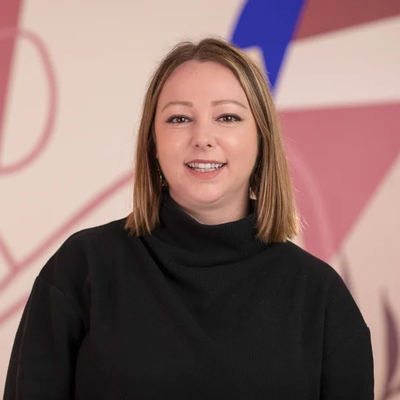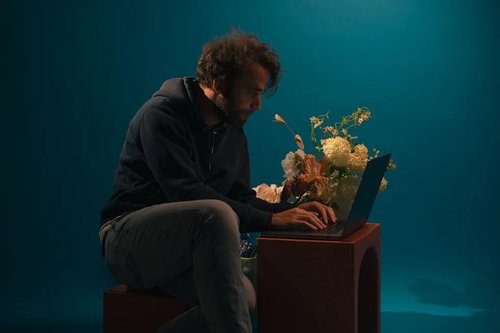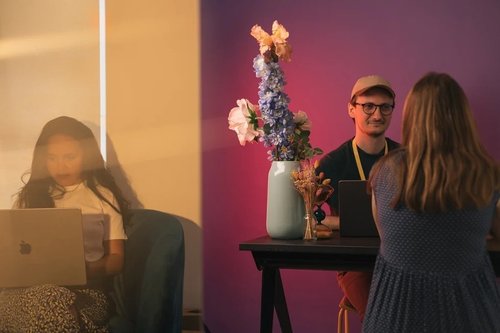How social media professionals cope in an always-on world
02 oct 2023
7 min


US Editor at Welcome to the Jungle
Using social media has become routine for the 302 million Americans who spend more than two hours a day on various platforms. In theory, this is a great way to foster social connection – an essential human need – and reduce isolation. Sadly, that’s not always how it works. Some studies show that habitual engagement can lead to increased anxiety, depression, and loneliness.
Many of us can ignore social media if we want to, but that’s not the case for social media marketers (SMMs), such as community and social media managers. Their roles demand an extraordinary degree of online engagement, trapping them into a relentless cycle dictated by the 24/7 news environment.
So it is hardly surprising that the roles have a high turnover rate. According to an analysis of the more than 27,000 social media managers working in the US by Zippia, 29% leave their positions within a year. In another study of more than 400 social media managers conducted for the Institute for Public Relations (IPR) Digital Media Research Center, Ragan Communications, and the University of Florida, 57% said they didn’t anticipate staying in their positions for more than two years, with half contemplating leaving their career in social media.
The key to this high churn rate lies in the IPR study, which shows that 47% of respondents believe they work more than their colleagues, while 55% say they typically work more than the standard 40 hours a week. To compound these challenges, some SMMs feel under pressure to use their personal digital profiles to promote the brands they represent at work.
So how do SMMs balance their personal and professional online presence when the boundaries are blurred and it has become increasingly challenging to disconnect? To find out, we spoke to two social media managers.
When screens rule your life
For social media managers dealing with content creation, instant responses, and relentless trend-tracking, the distinction between their professional and personal lives can fade soon after taking up a role. This was the case for Brittany Thomas-Garcia, a global social media manager. “I started to overshare and post everything about my life and that came with opinions, which definitely started to affect me,” she says.
It was 2014 when she began her career, a time when Instagram and influencers were beginning to take off. “I worked for a fitness company and – as you can imagine – pushing body perfection took its toll on me. I felt like I was promoting this lifestyle in my job and felt pressure to adopt it in my own life,” she says. “However, I think I did this in an unhealthy way.”
Early on in her career, Thomas-Garcia began to feel like she was burning out, but she didn’t want to curtail her personal use of social media as she thought it was important for her career. “Anything I was doing for work, such as an event or a new product release, I would promote and tag my employer [on personal accounts too],” she says.
When she first got her role in social media, Jessica Dulaney, a social media manager, communications strategist, and the founder of the digital consultancy agency CloverScribe, says she moved into “crisis communication” mode and was continually scrolling or posting. “I became utterly hooked on the fast-paced nature of social media,” she says. Dulaney also used her personal social media accounts to promote her professional work, saying she “spent a lot of time each day on social media in both personal and professional capacities.”
Even today, she uses her personal accounts to promote her career and her employer. “Like many social media managers, I find that the personal and professional aspects often intertwine. I’ll retweet a brand post guiding my personal followers’ attention to my work,” she says.
How Covid-19 affected social media usage
The pandemic presented significant challenges for SMMs, according to Dulaney. “As everything shifted online, the public leaned heavily on our channels for their questions, concerns, and the latest news,” she says, adding that this meant she had to be hypervigilant, always watching the content queue, and making adjustments based on changing advice from the authorities. “I felt I couldn’t leave my phones out of sight. I had to be constantly available, which led to a level of stress I had never previously experienced,” Dulaney says. She found that many of her friends and colleagues in the field had similar experiences.
Dulaney reassessed her personal usage habits. “I realized I was using social media as a crutch, a distraction from something else that seemed stressful,” she says. To manage her professional demands during the pandemic, Dulaney chose to limit her personal usage. “I ended up cutting back on my personal use because there was no time…I had to focus on my work,” she says. Dulaney viewed it as a chance to examine her relationship with these platforms. “I had the opportunity then to make social media work for me versus being dragged around in a circle by it,” she adds.
The pandemic forced other SMMs, such as Thomas-Garcia, to confront feelings of burnout head-on and reevaluate their engagement with social media. Some opted for a ‘relationship status update’ with their personal accounts, reassessing how and what they shared. Despite her feelings of being overwhelmed early in her career, Thomas-Garcia continued to post about her career and promote her employer through her personal accounts until 2020. “I was using every platform possible and sharing on all of them,” she says.
The extra pressure during the pandemic was affecting her mental health, so she decided to limit her personal use. “[I was] juggling social media for work and personal use, the barrage of unsettling comments became overwhelming. People seemed to become more audacious during that uncertain time,” she adds. “[At the beginning of the pandemic,] I deleted all but one platform: TikTok. I had reached my limit. It was affecting my mental health too greatly,” she says.
Finding what works
After Thomas-Garcia decided to take a break from Instagram between 2020 and 2023, she felt like she had almost been forgotten. “[It] made me realize that I wasn’t as connected to some people as I had assumed,” she says. This created a shift in her approach to her relationships, making her “much more intentional about showing up for people in real life.”
These days, her personal interactions are primarily limited to Instagram and TikTok. “However, I keep those accounts pretty private, mainly for close friends and family,” she adds.
She reviews her digital circles regularly. “I tend to periodically go through and adjust who I follow and who follows me,” she says, highlighting the importance of not being “constantly updated on the lives of everyone I’ve ever encountered.” On the professional front, she relies on LinkedIn but deliberately keeps a distance from platforms like Twitter/X and Facebook, labeling them as “rabbit holes that I prefer to avoid.” She has also stopped promoting her employer’s image. “No one on my personal accounts, besides LinkedIn, would know where I work,” she says.
Dulaney also takes an analytical approach. She considers why she is on each platform, asking herself: “What do I actually want to be doing when I’m on here?” She avoids certain platforms, such as TikTok and Reddit, and tries to spend less time on Twitter/X and other platforms. She is selective when adopting new platforms and has developed rules to help her to maintain control, such as not installing ‘trigger’ apps on her phone. She also regularly assesses how much time she spends looking at screens, prioritizes positive messaging and unplugs for real-life experiences. She occasionally uses her personal accounts, such as LinkedIn, to engage with content related to her work. But there’s no internal or external pressure to do so. “A post’s success doesn’t hinge on whether I personally like, comment, and subscribe,” she adds.
Striking a balance on her other projects has been more difficult as Dulaney also advocates to make homeschooling safer and better for children. “My personal brand and my advocacy work are intertwined, and both have a significant social media component,” she says. Despite her difficulty logging off, she is working on taking a more structured approach so as to maximize her time and energy.
Taking care of your mental health
You don’t have to let social media take over your life, even if it’s your career. Both Dulaney and Thomas-Garcia still work in the industry and are happy with it. They are finding ways to like their profession without letting it follow them home.
Dulaney advises taking time to reflect on your relationship with social media from a personal perspective. “What are you actually doing on a day-to-day basis on it?” Comparing how you use the platforms to how you would ideally like to use them is crucial for mental health. “When you say yes to social media, what is it you’re saying no to?” she says, pointing out that it’s worth weighing the trade-offs, such as reading a book, listening to a podcast, spending time with loved ones, or playing with your pet.
Similarly, Thomas-Garcia advises nurturing an offline community. “Social media can make it challenging to engage with others in person. It’s also important to curate who follows you and who you follow.” Use tools such as ‘unfollow,’ ‘remove follower,’ or ‘block’ when necessary to ensure your online environment consists of supportive and respectful individuals, making the experience more enjoyable, she says. “Social media should never control your life,” she says. Remember, there is life beyond the screen. So why not get out there and experience it?
Redefining success on social media
Success in the world of social media doesn’t necessitate spending dawn to dusk online, Dulaney says. “You don’t need to be a hyper-online person… scrolling as soon as you wake up and falling asleep with the phone on your face,” she says. Instead of constant scrolling, staying aware of industry happenings and trends, and maintaining a sharp skillset are the keys to success, explains Dulaney.
SMMs are supposed to be seen as “social media wizards,” individuals who are “always online,” or as those who know “what the TikTok trending sound is before it gets big,” says Dulaney. Nevertheless, she believes the industry will come to realize that using one’s personal accounts isn’t essential to the role as the issue is gaining recognition. “Many individuals in our community generously share their advice, providing guidance on communicating your sense of being overwhelmed to your superiors.” This is a step in the right direction, she adds.
A well-curated personal social media account is not a requirement for hiring, says Dulaney. “A solid portfolio showcasing previous brand work or even speculative projects can be equally, if not more, impactful,” she adds. Her emphasis is on an applicant’s ability to demonstrate copywriting, design, and strategy skills through past work or mock-up projects. Some of the best social media managers she has met were not regular personal posters. Their “creative energy” was devoted to their work, focusing on enhancing other people’s brands over their own, she says.
Thomas-Garcia says that this attitude hasn’t always helped in interviews. “Recently, in my career, I’ve started to be candid and vocal about how I limit my social media use in my personal life. This choice has led to missed interviews and job opportunities,” she says. Yet, she believes in looking at the bigger picture. “Anyone with long-term experience in social media understands the detrimental effects that seemingly perpetual online presence can inflict,” she says. Achieving balance might not be easy, but it’s worth it for your own personal happiness online and offline.
Photo: Welcome to the Jungle
Follow Welcome to the Jungle on Facebook on LinkedIn and on Instagram and subscribe to our newsletter to get our latest articles every day!

Más inspiración: Work-life balance

Back to school: How to balance continuing education with work
Balancing work and school is manageable. Choose the right course, inform your boss and friends, build good habits and take breaks to avoid burnout.
31 jul 2024

Clash of cultures: Unpacking the RTO conundrum
RTO mandates are a troubling trend in the workplace. So, what do workers and employers really think of it?
23 jul 2024

The 4-day workweek: 50 things we couldn't do without it
What would you do with one extra off day per week?
19 feb 2024

Does working eight hours a day really make sense?
The eight-hour workday may seem like a staple of modern work, but is it really necessary?
11 oct 2023

Struggling to disconnect on vacation? You are not alone
As excessive screen time increasingly defines our working lives, more than half of Americans can't fully unplug during their time off
11 ene 2023

¿Estás buscando tu próxima oportunidad laboral?
Más de 200.000 candidatos han encontrado trabajo en Welcome to the Jungle
Explorar ofertas